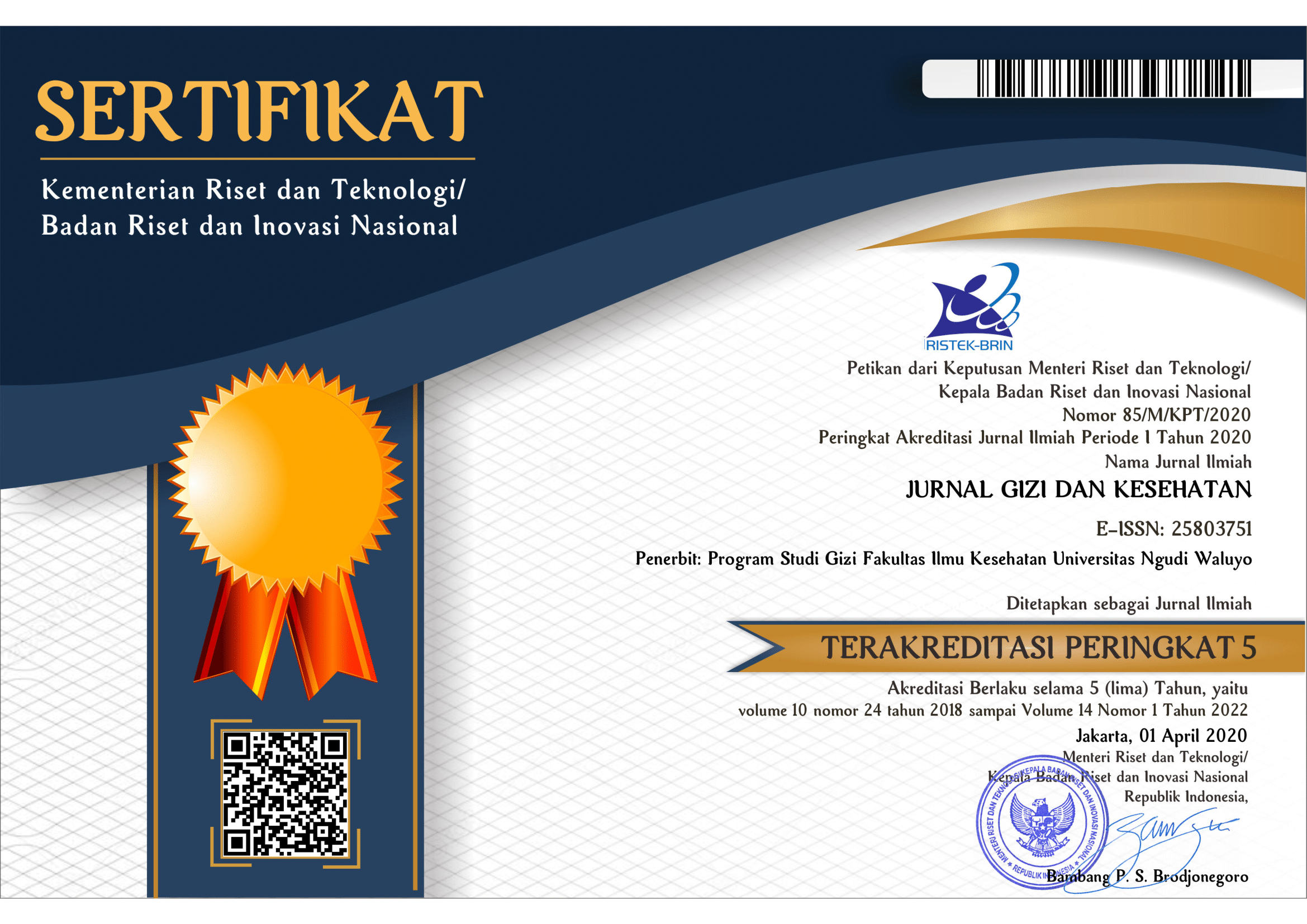PENGARUH JUS TOMAT TERHADAP PROFIL LIPID PADA PENDERITA DISLIPIDEMIA
EFFECT OF TOMATO JUICE ON LIPID PROFILE IN DYSLIPIDEMIC PATIENTS
DOI:
https://doi.org/10.35473/jgk.v11i26.50Keywords:
Profil Lipid, Likopen, Jus Tomat, AterosklerosisAbstract
Background :High LDL cholesterol can develop into atherosclerosis. Tomatoes contain lots of lycopene which plays a role in protecting fat from peroxidation which reacts with hydroperoxyl fat by binding to free radicals. Lycopene is known to play a role in preventing several important chronic diseases, one of which is atherosclerosis.
Method :The research design was a quasi experiment control design with pre post test. The subjects of the study were 62 employees of Kendal Hospital, aged 35-50 years, suffering from dyslipidemia and not suffering from metabolic or degenerative diseases based on the examination of a specialist in internal medicine. Subjects were divided into 2 groups, each with 31 subjects. Group I was given ripe tomato juice 336 grams per day for 21 days and group II as a control. Data analysis using Kolmogorov Smirnov test, Mann Whitney test and Independent Samples t-test.Conclusion withdrawal uses a confidence level of 95% (α = 0.05).
Results:There was a reduction in total cholesterol levels of 29.6 gr / dl (p = 0.00), LDL levels 32.5 gr / dl (p = 0.00), triglyceridelevels 41.4 gr / dl (p = 0.01).
Conclusion :The administration of tomato juice can reduce total cholesterol, LDL and triglyceride
Abstrak :
Latar Belakang : Kadar kolesterol LDL yang tinggi dapat berkembang menjadi aterosklerosis. Tomat mengandung banyak likopen yang berperan dalam melindungi lemak dari peroksidasi yang bereaksi dengan hidroperoksil lemak dengan cara mengikat radikal bebas. Likopen diketahui mampu berperan mencegah beberapa penyakit kronis penting salah satu diantaranya aterosklerosis. Penelitian ini untuk mengetahui perbedaan perubahan profil lipid penderita dislipidemia.
Metode : Rancangan penelitian adalah quasi experiment control design with pre post test. Subyek penelitian 62 karyawati RSUD Kendal, umur 35 – 50 tahun, menderita dislipidemia dan tidak menderita penyakit metabolik atau degeneratif berdasarkan dari pemeriksaan dokter spesialis penyakit dalam. Subyek dibagi 2 kelompok masing-masing 31 subyek. Kelompok I diberikan jus tomat matang 336 gram per hari selama 21 hari dan kelompok II sebagai kontrol. Analisa data menggunakan uji Kolmogorov Smirnov, uji Mann Whitney dan Independent Samples t-test. Penarikan simpulan menggunakan tingkat kepercayaan 95% (α = 0,05).
Hasil Penelitian : Ada penurunan kadar kolesterol total 29.6 gr/dl (p = 0,001), kadar LDL 32.5 gr/dl (p = 0,001) , kadar trigliserida 41.4 gr/dl (p = 0,01)
Simpulan : Pemberian jus tomat dapat menurunkan kadar kolesterol, kadar LDL dan kadar
trigliserida
Downloads
References
Kahn HS. The Lipid Accumulation Product Ferforms Better than the Body Mass Index for Recognizing Cardiovascular Risk : A Population Based Comparation, BMC Cardiovascular Disorders. 2006.
Fernandes RA et al.Prevalence of Dyslipidemia in Individuals Physically Active during Childhood, Adolescence and Adult Age. Arq Bras Cardiol 2011;97(4):317-323
Badan Pusat Ststistik. Survei Konsumsi Rumah Tangga, 2004
Departemen Kesehatan Republik Indonesia, Laporan Hasil Riset Kesehatan Dasar : Prevalensi Obesitas Umum Penduduk Dewasa Menurut Jenis Kelamin dan Propinsi. Badan Penelitian dan Pengembangan Kesehatan. 2007 : 50
Departemen Kesehatan Republik Indonesia, Laporan Hasil Riset Kesehatan Dasar : Prevalensi Obesitas Sentral Penduduk Dewasa Menurut Propinsi. Badan Penelitian dan Pengembangan Kesehatan. 2007 : 52
Departemen Kesehatan Republik Indonesia, Laporan Hasil Riset Kesehatan Dasar : Persentase Status Gizi Penduduk Dewasa Menurut Kategori IMT, Jenis Kelamin dan Propinsi. Badan Penelitian dan Pengembangan Kesehatan. 2010 : 69
Krisnansari D. Pengaruh Suplementasi Vitamin E terhadap Profil Lipid Penderita Dislipidemia. 2009. Tesis S2 Gizi UNDIP.
Nelms M et al. 2010. Nutrition Therapy and Pathophysiology Second Edition
Rakesh SU et al. Use of Natural Antioxidants to Scavenge Free Radicals: A Major Cause of Diseases. International Journal of PharmTech Research CODEN (USA): IJPRIF ISSN :0974-4304 Vol.2, No.2, pp 1074-1081, April-June 2010. Didownload melalui www.sphinxsai.com pada 22 September 2013.
Tyssandier V et al. Vegetable-Borne Lutein, Lycopene, and _Carotene Compete for Incorporation into Chylomicrons, with no Adverse Effect on the Medium-term (3-wk) Plasma Status of Carotenoids in Humans1–3. Am J Clin Nutr 2002;75:526–34. Downloaded from ajcn.nutrition.org by guest on August 28, 2013.
Rissanen TH et al. Serum Lycopene Concentrtions and Carotid Atherosclerosis
: The Kuopio Ischaemic Heart Disease Risk Factor Study. Am J Clin Nutr 2003;77 (1):133-8.
Marks, DB et al. alih Bahasa Brahm U Pendit. Biokimia Kedokteran Dasar. Sebuah Pendekatan Klinis, EGC. Jakara, 2000. 321-336, 481-545.
Sachin Uttam Rakesh et al. Use of Natural Antioxidants to Scavenge Free Radicals: A Major Cause of Diseases. I J Pharm Tech. 2010 Vol.2 No. 2, pp 1074-1082.
Visioli F, Riso P, Grande S, Galli C and Porrin M. Protective activity of tomato products on in vivo markers of lipid oxidation. Eur J Nurt. 2003; 42 (4):201-6
Collins JK et al. Lycopene From Two Food Sources Does not Affect Antioxidant or Cholesterol Status of Middle-Aged Adult. Nutrition Journal 2004, 3:15 (88)100
Haryanti EHW. Pengaruh Pemberian Likopen terhadap Profil Lipid dan Lipid Terperoksidai Serum Tikus Hiperkolesterolemia. Perpustakaan Pasca Sarjana Universitas Diponegoro. 2006. Tesis S2 Biomedik.
Aru W Sudoyo dkk. Buku Ajar Ilmu Penyakit Dalam Jilid III Edisi IV. Pusat Penerbit Departemen Ilmu Penyakit Dalam FKUI 2006; 1948 – 1953.
Bahri Anwar, T. Dislipidemia Sebagai Faktor Resiko Penyakit Jantung Koroner. Fakultas Kedokteran Universetas Sumatera Utara 2008.
Purwaningsih Endang dan Sugiri. Gizi dan Kesehatan Jantung. Harapan Baru Pencegahan dan Pengololaan Penyakit Jantung Iskemik. Badan Penerbitan Universitas Diponegoro Semarang 2008.
Perkumpulan Endorinologi Indonesia (PERKENI). Petunjuk Praktis Pengelolaan Diabetus Melitus. 2002.
Murray R K et al. Biokimia Harper. EGC. Jakarta edisi 27. 2009;15:128-138; 25:225-249
Stump SE. Nutrition and Diagnosis- Related Care. 2008; 7th ed: 307-357
Gropper SS dan Smith JL. Advanced Nutritrion and Human Metabolism 5th ed. Belmont (CA) : Wadsworth Cengage Leaning ; 2009
Eckel RH et al. Understanding the Complexity of Trans Fatty Acid Reduction in the American Diet: American Heart Association Trans Fat Conference 2006: Report of the Trans Fat Conference Planning Group. Circulation. 2007;115:2231–46.
Oluwabunmi A Tokedeet al. Plasma phospholipid trans fatty acids and risk of heart failure1,2,3. 2013 American Society for Nutrition. Didownload dari www.ajcn.org pada tanggal 28 Agustus 2013.
Mozaffarian D et al. Dietary Intake of Trans Fatty Acids and Systemic Inflammation in Women. Am J Clin Nutr. 2004;79:606–12.
Rodenas S et al. Dietary Exchange of an Olive Oil and Sunflower Oil Blend for Extra Virgin Olive Oil Decreases the Estimate Cardiovascular Risk and LDL and Apolipoprotein AII Concentrations in Postmenopausal Women. J Am Coll Nutr. 2005;24:361–69.
Trichopoulou A. Costacou T, Bamia C, Trichopoulos D. Adherence toa Mediterranean diet and survival in a Greek population. New England Journalof Medicine. 2003;348:2599–2608.
Pereira MA et al. Dietary Fiber and Risk of Coronary Heart Disease: a Pooled Analysis of Cohort Studies. Arch Intern Med. 2004;164: 370–76.
Anne Le Kim et al. Fructose Overconsumption Causes Dyslipidemia and Ectopic Lipid Deposition in Healthy Subjects with and without a Family History of type 2 Diabetes1–4 .Am J Clin Nutr 2009;89:1760–5. Downloaded from ajcn.nutrition.org by guest on August 28, 2013
Krauss RM et al. Separate Effects of Reduced Carbohydrate Intake and Weight Loss Onatherogenic Dyslipidemia1–3. Am J Clin Nutr 2006;83:1025–31. Downloaded from ajcn.nutrition.org by guest on August 28, 2013.
Hansen et al.Effect of Red Wine and Red Grape Extract on Blood Lipids, Haemostatic Factor and Other Risk Factors for Cardiovascular Disease. Eur J Clin Nutr. 2005;55:449
Lairon et al.Dietary Fiber Intake and Risk Factors for Cardiovascular Disease in French Adults. Am J Clin Nutr. 2005;82:1185
Slavin JL. Dietary Fiber and Body weight. Nutrition. 2005;21:411–18
Oguma dan Shinoda-Tagawa. Physical Activity Decreases Cardiovascular Disease Risk in Women : Review and Meta-Analysis. Am J Prev Med. 2004;26:407.
Granjean PW et al. Infuence of Cholesterol on Blood Lipid and Lipoprotein Enzyme Resposes to Aerobic Exercise. J. Appl Physiol 2000; 89 : 472
– 480.
Ebbert Jon O and Jensen Michael D. Review : Fat Depots, Free Fatty Acids, and Dyslipidemia. Nutrients 2013, 5, 498- 508
Delmi Sulastri, Sri Rahayuningsih, Purwantyastuti. Pola Asupan Lemak, Serat, dan Antioksidan, serta Hubungannya dengan Profil Lipid pada Laki-laki Etnik Minangkabau. Majalah Kedokteran Indonesia, 2005; Volum: 55, Nomor: 2.
Poirier P et al. 2006. Obesity and cardiovascular disease: Pathophysiology, Evaluation and Effect of Weight Loss. Circ.2006;113:898–918
Sugiri. Peran Penataan Gaya Hidup dalaam Pencegahan Serangan Jantung. Fakultas Kedokteran UNDIP, Semarang. 2008.
Ambrose JA, Barua RS. The Pathophysiology of Cigarette Smoking and Cardiovascular Disease. J Am Coll Cardiol 2004;43:1731–37.
American Heart Association. Heart Disease and Stroke Statistics_2009 Update: A Report From the American
Heart Association Statistics Committee and Stroke Statistics Subcommittee. Circulation 2009;119:e21–e181.
Barnard DD. Heart Failure in Women. Curr Cardiol Rep. 2005;7:159–65.
Husaini, M.A. Gizi, Proses Penuaan dan Umur Panjang. Pusat Penelitian dan Pengembangan Gizi, Departemen Kesehatan RI, Bogor. 2001. 2001.
Arab Lenore dan Steck Susan, Lycopene and Cardiovascular disease1–3. Am J Clin Nutr 2000;71(suppl):1691S–5S. Downloaded from ajcn.nutrition.org by guest on August 28, 2013
Riessanen TH. Association of Lycopene and Dietary Intake of Fruits, Berries, and Vegetables with Atherosclerosis and CVD. Departement Of Publich Health and General Practise: University Of Kuopio. Disertation.2003
Wang XD. Lycopene Metabolism and its Biological Significance. Am J Clin Nutr 2012;96(suppl):1214S–22S. Downloaded from ajcn.nutrition.orgat INRA Institut National de la Recherche Agronomique on June 21, 2013.
Voutilainen S et al. Carotenoids and Cardiovascular Health. Am J Clin Nutr 2006;83:1265–71
Alastair B Ross et al. Lycopene Bioavailability and Metabolism in Humans: an Accelerator Mass Spectrometry Study. Am J Clin Nutr 2011;93:1263–73. Downloaded from ajcn.nutrition.org by guest on August 28, 2013
Bramley PM. Is Lycopene Benefical to Human Health ? Phytochemistry. 2000;54:233-234.
Agarwal S and Rao AV. Tomato Lycopene and Its Role in Human Health and Chronic Diseases. CMAJ 2000. 163(6):739-744.
Cohn W et al. Comparative Multiple Dose Plasma Kinetics of Lycopene Administered in Tomato Juice, Tomato
Soup or Tomato Oleoresin. Eur. J. Nutr. 2004;43:304-312.
Nadiyono dkk. ”Perkiraan Besaran Sampel”. dalam Sastroasmoro Sudigdo dan Ismoel S. Dasar – Dasar Metodologi Penelitian Klinis. Edisi ke 2, CV. Sagung Seto. 2002. hal. 268-9
Dahlan M. Sopiyudin. Statistik untuk Kedokteran dan Kesehatan. Edisi 5. Salemba Medika. 2013
SessoHoward Det al. Plasma Lycopene, Other Carotenoids and Retinol and The Risk of Cardiovascular Disease in Women. Am J Clin Nutr 2004;79:47-53
Soeharto. Serangan Jantung dan Stroke Hubungannya dengan Lemak dan Kolesterol Edisi kedua. Gramedia Pusat.2004
Marit EJ et al. Lifestyle Modifies Obesity-Assosiated Risk of Cardiovascular Disease in A Genetically Homogeneous Population. Am J Clin Nutr 2006;84:29-36.
Andrew S Greenberg and Martin S Obin. Obesity and Role Adipose Tissue in Metabolism. Am J Clin Nutr 2006;83(suppl):461S-5S.
Denis Lairon et al. Dietary Fiber Intake and Risk Factors for Cardiovascular Disease in French Adults. Am J Clin Nutr 2005;82:1185-94
Sesso Howard D et al. Plasma Lycopene, Other Carotenoids and Retinol and The Risk of Cardiovascular Disease in Men. Am J Clin Nutr 2005;81:990-7
Rissanen TH et al. Low Serum Lycopene Concentration is Associated with An Excess Incidence of Acute Coronary Events and Stroke : The Kupio Ischaemic Heart Disease Risk Factor Study. Br J Nutr 2001;85:749-54
L. Kathleen Mahan, Sylvia Escott-Stump and Janice L. Raymond. Krause’s Food & The Nutrition Care Process. Edisition 13th. USA. 2012;34:742-48.










